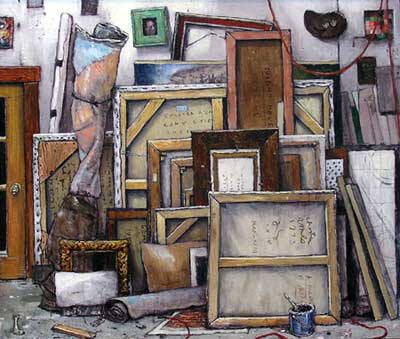An art dealer expounding on the difference between hacks and has-beens said that in the right market, the work of a hack can be sold, but a has-been has no market. For art critics, the situation is the reverse. A has-been may be only a brilliant defense short of reemergence, but about a hack there is nothing to say.
In spite of the categories into which others try to tidy them away, artists continue. Why? Virginia Woolf attempted an answer in the person of Lily Briscoe, a painter of little or no prominence in To The Lighthouse.
Lily stepped back to get her canvas – so – into perspective. It was an odd road to be walking, this of painting. Out and out one went, further and further, until at last one seemed to be on a narrow plank, perfectly alone, over the sea.
…Why then did she do it? She looked at the canvas, lightly scored with running lines. It would be hung in the servants’ bedrooms. It would be rolled up and stuffed under a sofa. What was the good of doing it then, and she heard some voice saying she couldn’t paint, saying she couldn’t create, as if she were caught up in one of those habitual currents in which after a certain time experience forms in the mind, so that one repeats words without being aware any longer of who originally spoke them.
Can’t paint, can’t write, she murmured monotonously, anxiously considering what her plan of attack should be. For the mass loomed before her; it protruded; she felt it pressing on her eyeballs. Then, as if some juice necessary for the lubrication of her faculties were spontaneously squirted, she began precariously dipping among the blues and umbers, moving her brush hither and thither, but it was now heavier and went slow, as if it had fallen in with some rhythm which was dictated to her (she kept looking at the hedge, at the canvas) by what she saw, so that while her hand quivered with life, this rhythm was strong enough to bear her along with it on its current. Certainly she was losing consciousness of outer things. And as she lost consciousness of outer things, and her name and her personality and her appearance, and whether Mr. Carmichael was there or not, her mind kept throwing up from its depths, scenes, and names and sayings, and memories and ideas, like a fountain spurting over that glaring, hideously difficult white space, while she modeled it with greens and blues.
…
Quickly, as if she were recalled by something over there, she turned to her canvas. There it was – her picture. Yes, with all its greens and blues, its lines running up and across, its attempt at something. It would be hung in the attics, she thought; it would be destroyed. But what did that matter? she asked herself, taking up her brush again. She looked at the steps; they were empty; she looked at her canvas; it was blurred. With a sudden intensity, as if she saw it clear for a second, she drew a line there, in the centre. It was done; it was finished. Yes, she thought, laying down her brush in extreme fatigue, I have had my vision.
Chester Arnold, Inventory, 2005, 22 x 26, oil/linen




Hacks and has-beens? If there were a club by that name, I’d join it.
That’s great, the part from “To The Lighthouse” zeroing in and losing consciousness of everything else. People who aren’t artists have to get high to get there.
What a depressing way to think about what artists create. They have visions that nobody cares about. Paintings wind up rolled behind sofas. It isn’t true. More people appreciate art now than ever before.
Hey Philip. I don’t see depressing. I was heartened.
In the end there is no place better than the work. The studio, in my case, is the place. No amount of success or accolades can change that the artistic life can’t be beat. I get to distill my life all over again, every heartbreak, every conversation, every artistic impulse, and what that makes me do is live my life every single day open. If it can be broken down to a form, or reference mark, it would in my case, Dickensian. You can’t take away what we [artists] do, you can send me rejections from shows, commissions, no sales, if you are making art to be shown, you are wasting your time, make art because you love to make the work. I take the Charlie Kaufman line from Adaptation, “You are what you love, not what loves you”.